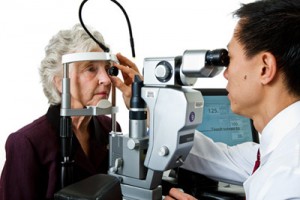This National Diabetes Month, remember to keep an eye on your eyes
This National Diabetes Month, remember to keep an eye on your eyes
If you are one of more than 25 million Americans with diabetes, you may already know the importance of watching your diet and keeping track of your blood sugar. But did you know it’s also important to have regular eye exams?
In the United States, diabetic eye disease is the leading cause of vision loss among working-age adults. Diabetic retinopathy is the most common form of this disease, and affects about 28.5 percent of Americans with diabetes age 40 and older. That’s more than 7 million people, and the number is expected to reach more than 11 million by the year 2030.
The condition can creep up quietly. It gradually weakens small blood vessels in and around the retina, the light-sensing layer of tissue at the back of the eye. If the disease progresses, these vessels may rupture and leak blood into the eye; they can also spread and grow on the surface of the retina and cause scarring.
Typically, diabetic retinopathy has no symptoms until it reaches an advanced stage. But the disease can be detected early through a comprehensive dilated eye exam. In this procedure, an eye professional will put drops in your eye to dilate (widen) the pupil, which allows a closer look at the retina.
The good news is that with early detection, timely treatment, and appropriate follow-up, the risk of severe vision loss from diabetic retinopathy can be reduced by 95 percent. There are several effective treatment options including laser surgery and injections of anti-VEGF drugs. These drugs block the actions of a protein that can cause abnormal blood vessels to grow and leak fluid.

A comprehensive dilated eye exam can catch diabetic eye disease early, before symptoms appear.
November is National Diabetes Month. If you have diabetes, it’s a good time to remember these health tips:
- Get a comprehensive dilated eye exam at least once a year.
- Control your blood sugar, blood pressure and cholesterol levels. By controlling your diabetes, you’ll reduce your risk of diabetic eye disease.
- Talk to your eye care professional about diabetic retinopathy.
- Learn more about diabetic eye disease from the National Eye Institute, part of the National Institutes of Health.
- Learn more about preventing and managing diabetes from the National Diabetes Education Program
NEI’s Diabetic Retinopathy Clinical Research Network (DRCR.net) conducts large multi-center trials of new therapies for diabetic eye disease; it comprises nearly 1000 investigators at sites in 48 states. Many of the sites are private practice eye clinics, enabling the network to quickly bring innovative treatments from research into community practice. An ongoing trial is comparing three anti-VEGF drugs for macular edema, a complication of diabetic retinopathy that causes central vision loss. For more information, please see trial NCT01627249 at http://www.clinicaltrials.gov
The National Eye Institute, part of the National Institutes of Health, leads the federal government’s research on the visual system and eye diseases. NEI supports basic and clinical science programs that result in the development of sight-saving treatments. For more information, visit http://www.nei.nih.gov
…
National Eye Institute doctor explains diabetic eye disease, and how to treat the condition.
…
###
* The above story is reprinted from materials provided by National Institutes of Health (NIH)** The National Institutes of Health (NIH) , a part of the U.S. Department of Health and Human Services, is the nation’s medical research agency—making important discoveries that improve health and save lives. The National Institutes of Health is made up of 27 different components called Institutes and Centers. Each has its own specific research agenda. All but three of these components receive their funding directly from Congress, and administrate their own budgets.



















